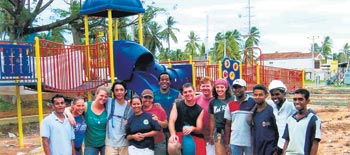|
Bringing
fun and laughter to a place of sad memories
American University students help
build a play park in Hambantota at the site of a market
place washed away in the 2004 tsunami
By Zack Taylor
HAMBANTOTA—Seven students from
an American University volunteered for an unusual overseas
development project and found that something as simple
as building a play park for children could have a profound
impact on themselves and the local community.
The team members themselves dug into
the rock-hard soil of a former market site and transformed
it into a state-of-the-art play park. The park is one
of 85 that the U.S. Agency for International Development
(USAID) is building in tsunami-affected districts to
help restore communities to normalcy, and especially
to help children overcome the psychological trauma of
the event through “play therapy.” The $2
million project is co-funded by USAID, the Jewish Joint
Distribution Centre, and the Bush-Clinton Tsunami Fund.
 |
| Students from Oral Roberts University
who constructed the Hambantota playground and friends
include: (from second left) Rachel Hansen, Kelly
Chase, Vince Narciso, Ruby Libertus (advisor), Alina
Pedigo, William Jones, Michale Robinson, and Sara
Mazzurcca (in bandana). |
A young professor of international
development at Oral Roberts University (ORU) in Tulsa,
Oklahoma, Ruby Libertus, brought the students to Sri
Lanka. Ruby is of Sri Lankan-Finnish descent and grew
up all over the world. But she spent enough time in
Sri Lanka to absorb the culture and language, and considers
the country her homeland.
“I was devastated to see the
affects of the tsunami on Sri Lanka, which is an important
part of my heritage,” Ruby said. “I felt
helpless, and wanted to do more for the people, but
I had made a commitment to the university.”
ORU provided an opportunity for her
to return to Sri Lanka as part of a new overseas volunteer
project for interested students. Ruby suggested the
play parks in Sri Lanka for the project. “I’m
naturally biased, but I felt in my heart it should be
some sort of tsunami relief in Sri Lanka,” she
said. The university liked the idea and soon a team
of seven volunteers, mostly development or international
relations students, assembled. Each team member raised
$3,200 in donations to finance the trip.
At the end of the school year in 2006,
the ORU team arrived in Sri Lanka and USAID staff facilitated
the team’s work for a play park in Hambantota.
Team leader Sara Mazzucca, 23, had
just graduated from ORU with a degree in development
and the project gave her a keen awareness of the realities
of working internationally. In the face of such a tragedy,
she said, no amount of work can truly restore what the
people have lost. “We tried to help, but as much
as we did, we couldn’t give them their lives back.
But USAID did help us to contribute as Americans, and
we’re really proud of that.”
The community took a keen interest
in what the young foreigners were doing, watching, honking
horns, and waving at them. Soon after, friendships were
forged and local residents shared their stories of the
tsunami. “One man told us about his 14-year-old
son who died here,” said Michale Robinson, a 23-year
old senior majoring in communications and business management,
who had done development work but not outside the U.S.
“He told us he wanted the park to last forever
as a memorial to his son.”
Challenges to completing the park
included land ownership issues and obtaining sand, as
sand available for building has been in short supply
since the tsunami. Sara said that she learned a lot
about how challenging it is to get things done. She
said she was inspired by the work of Ravina Deepanayana,
team leader for Sarvodaya, USAID’s implementing
partner, who worked tirelessly to obtain the necessary
authorizations for the project.
The team agreed that there were many
rewards, including the unsolicited assistance and cooperation
they received from the people of Hambantota. Three-wheeled
taxi drivers helped them hunt down necessary equipment,
women brought refreshments of bananas and thambili,
and even the mayor of Hambantota visited the project
site and invited Ruby and Sara to his home.
The residents were fascinated by this
group of young women and men digging in the dirt and
moving equipment, and offered to lend a hand.
“I think our work ethic really
shone through and brought the team together,”
said Vince Narciso, 24, a senior majoring in international
relations. “If we had come to boss people around
and not work hard, they wouldn’t have tried either.
But they saw that we were a dedicated team. We got a
lot done together with our local friends, whether or
not we could communicate verbally.”
The real satisfaction was the response
of the local children, who wanted to get to the equipment
even before it was completely and safely installed.
“There were hundreds,” said Vince. “We
were hard-pressed to keep them away from the site until
we had finished.”
“I wanted to inspire the students
to understand development,” Ruby said. “Building
a play park isn’t a typical project. But in this
case, we felt like we were restoring a little life in
a place that had previously represented tragedy and
sadness.”
|
